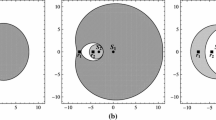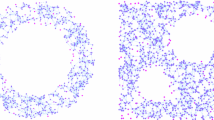Abstract
In this paper, we study the connectivity of multihop wireless networks with the log-normal shadowing model by investigating the critical transmission power required by each node for asymptotic vanishing of the isolated nodes, and the precise distribution of the number of isolated nodes. The vanishing of isolated nodes is not only a prerequisite but also a good indication of network connectivity. Most of the known works on network connectivity under such a shadowing model were obtained only based on simulation studies or ignoring the important boundary effect to avoid the challenging technical analysis, and thus hardly applied to practical wireless networks. It is extremely challenging to take the complicated boundary effect into consideration under such a realistic shadowing model because the transmission area of each node is an irregular region other than a circular area. Assume the wireless nodes are represented by a Poisson point process with density \(n\) over a unit-area disk. With the boundary effect taken into consideration, we first obtain an explicit formula for the expected number of isolated nodes, we then derive an upper and a lower bounds of the critical transmission power for asymptotic vanishing of the isolated nodes. The tightness of the upper and lower bounds for the critical transmission power are analyzed via numerical analysis by using the software engineering approach. When a wireless network consists of \(n\) nodes distributed independently and uniformly over a unit-area disk, we derive the precise distribution of the number of the isolated nodes under such a realistic shadowing model with the linear power assignment, taking the boundary effect into consideration.



Similar content being viewed by others
References
Bettstetter, C. (2004). On the connectivity of ad hoc networks. The Computer Journal, 47(4), 432–447.
Bettstetter, C. (2002). On the minimum node degree and connectivity of a wireless multihop network. In 3rd ACM International Symposium on Mobile Ad Hoc Networking and Computing, Lausanne (pp. 80–91).
Bettstetter, C., & Hartmann, C. (2005). Connectivity of wireless multihop networks in a shadow fading environment. Wireless Networks, 11(5), 571–579.
Bernhardt, R. C. (1987). Macroscopic diversity in frequency reuse systems. IEEE Journal of Selected Areas in Communications, –SAC 5, 862–878.
Bertoni, H. (2000). Radio propagation for modern wireless systems. Englewood Cliffs: Prentice-Hall PTR.
Cox, D. C., Murray, R., & Norris, A. (1984). 800 MHz attenuation measured in and around suburban houses. AT&T Bell Laboratories Technical Journal, 63(6), 921–954.
Gupta, P., & Kumar, P. R. (1999). Critical power for asymptotic connectivity in wireless networks. Stochastic Analysis, Control, Optimization and Applications, 547–566. doi:10.1007/978-1-4612-1784-8_33.
Hekmat, R., & Mieghem, P. V. (2006). Connectivity in wireless ad-hoc networks with a log-normal radio model. Mobile Networks and Applications, 11(3), 351–360.
Lalos, A., Di Renzo, M., Alonso, L., & Verikoukis, C. (2013). Impact of correlated log-normal shadowing on two-way network coded cooperative wireless networks. IEEE Communications Letters, 17(9), 1738–1741.
Li, Y., & Yang, Y. (2010). Asymptotic connectivity of large-scale wireless networks with a log-normal shadowing model. 2010 IEEE 71st vehicular technology conference (VTC 2010-Spring). IEEE
Mukherjee, S., & Avidor, D. (2005). On the probability distribution of the minimal number of hops between any pair of nodes in a bounded wireless ad-hoc network subject to fading. In International workshop on wireless ad-hoc networks (IWWAN). London, UK.
Mukherjee, S., & Avidor, D. (2008). Connectivity and transmit-energy considerations between any pair of nodes in a wireless ad hoc network subject to fading. IEEE Transactions on Vehicular Technology, 57(2), 1226–1242.
Meester, R., & Roy, R. (1996). Continuum percolation. Cambridge: Cambridge University Press.
Muetze, T., Stuedi, P., Kuhn, F., & Alonso, G. (2008). Understanding radio irregularity in wireless networks. In The 5th annual IEEE Communications Society conference on sensor, mesh and ad hoc communications and networks (SECON 2008).
Penrose, M. (1997). The longest edge of the random minimal spanning tree. The Annals of Applied Probability, 7(2), 340–361.
Penrose, M. (1999). A strong law for the longest edge of the minimal spanning tree. The Annals of Applied Probability, 27(1), 246–260.
Philips, T. K., Panwar, S. S., & Tantawi, A. N. (1989). Connectivity properties of a packet radio network model. IEEE Transactions on Information Theory, 35(5), 1044–1047.
Rappaport, T. S. (1996). Wireless communications: Principles and practice (1st ed.). Englewood Cliffs: Prentice Hall PTR.
Stuedi, P., Chinellato, O., & Alonso, G. (2005). Connectivity in the presence of shadowing in 802.11 ad hoc networks. In Proceedings of IEEE Wireless Communications and Networking Conference (WCNC) (pp. 2225–2230).
Takai, M., Martin, J., & Bagrodia, R. (2001). Effects of wireless physical layer modeling in mobile ad hoc networks. In ACM International Symposium on Mobile Ad Hoc Networking and Computing (MobiHoc), Long Beach, USA.
Wang, L., Argumedo, A., & Washington, W. (2014). Precise asymptotic distribution of the number of isolated nodes in wireless networks with lognormal shadowing. Applied Mathematics, 5(15), 2249.
Wan, P.-J., & Yi, C.-W. (2004). Asymptotic critical transmission radius and critical neighbor number for k-connectivity in wireless ad hoc networks. In MobiHoc, Roppongi, Japan.
Wang, L., Yi, C.-W., & Yao, F. (2008). Improved asymptotic bounds on critical transmission radius for greedy forward routing in wireless ad hoc networks. In ACM MobiHoc 2008, Hong Kong SAR, China.
Xue, F., & Kumar, P. (2004). The number of neighbors needed for connectivity of wireless networks. Wireless Networks, 10(2), 169–181.
Yi, C.-W., Wan, P.-J., Lin, K.-W., & Huang, C.-H. (2006). Asymptotic distribution of the number of isolated nodes in wireless ad hoc networks with unreliable nodes and links. In IEEE GLOBECOM 2006.
Zorzi, M., & Pupolin, S. (1995). Optimum transmission ranges in multihop packet radio networks in the presence of fading. IEEE Transactions on Communications, 43(7), 2201–2205.
Acknowledgments
The work of Dr. Lixin Wang in this paper is supported in part by the NSF Grant HRD-1238704 of USA.
Author information
Authors and Affiliations
Corresponding author
Appendix
Appendix
This appendix is dedicated to the proof of Theorem 3 in Sect. 4.
Proof of Theorem 3
Let \(X\) be a random point with uniform distribution over \({{\mathbb{D}}}\) and independent of \({\mathcal {P}}_{n}\). For any finite planar set \(V\) and any subset \(U\) of \(V,\) define \(h\left( U,V\right)\) as follows: \(h(U,V)\) \(=1\) if \(\left| U\right| =1\) and the node in \(U\) is isolated from all the nodes in \(V,\) and \(h(U,V)\) \(=0\) otherwise. Note that \({{\mathbb{D}}}\) is partitioned into two sub-regions \({\mathbb{D}}(1)\) and \({\mathbb{D}}(2)\) (see Fig. 2).
Let \(N\) denote the number of isolated nodes in the network, then by the Palm Theory,
To compute the integral, we equally partition the interval \([0,R_{n}]\) into \(k\) subintervals with \(r_{0}=0<\) \(r_{1}<\) \(r_{2}<\cdots <r_{k}=R_{n}.\) Let \(\triangle r_{i}=r_{i}-r_{i-1}=\frac{R_{n}}{k},\) where \(i=1,2,\ldots ,k.\)
First we calculate the integral on \({\mathbb{D}}(1)\). For any \(x\in {\mathbb{D}}(1),\) the disk \(D(x,R_{n})\) is divided into \(k-1\) concentric annuli and the center disk \(D(x,r_{1}).\) We consider the center disk \(D(x,r_{1})\) as an annulus with inner radius \(r_{0}=0\) and outer radius \(r_{1}.\) For each \(1\le i\le k,\) the \(i\)th annulus is the one with inner radius \(r_{i-1}\) and outer radius \(r_{i}.\) The area of the \(i\)th annulus can be written as \(2\pi r_{i}\triangle \widetilde{r_{i}},\) where
as \(k\rightarrow \infty .\) Let \(N_{i}\) denote the number of nodes in the \(i\)th annulus, \(1\le i\le k\), then \(N_{i}\) is a Poisson random variable with mean \(n(2\pi r_{i}\triangle \widetilde{r_{i}}).\) For every \(1\le i\le k,\) we have
For any \(x\in {\mathbb{D}}(1),\) we have
Therefore,
Next we calculate the integral on \({\mathbb{D}}(2)\). For any \(x\in {\mathbb{D}}(2),\) the region \(D(x,R_{n})\cap {{\mathbb{D}}}\) is divided into \(k-1\) concentric circular belt regions and the center disk \(D(x,r_{1}).\) For each \(1\le i\le k,\) the \(i\)th circular belt region (annulus if it is contained in \({{\mathbb{D}}}\)) is the one with inner radius \(r_{i-1}\) and outer radius \(r_{i}.\) Let \(l_{i}\) denote the arc length of the \(i\)th circular belt region and \(l_{i}^{\prime }=2\pi r_{i}-l_{i}\), then its area can be written as \(l_{i}\triangle \widetilde{r_{i}},\) where
as \(k\rightarrow \infty .\) (If the \(i\)th annulus is entirely contained in \({{\mathbb{D}}}\), then \(l_{i}=2\pi r_{i}.\)) Let \(N_{i}\) denote the number of nodes in the \(i\)th circular belt region, \(1\le i\le k\), then \(N_{i}\) is a Poisson random variable with mean \(n(l_{i}\triangle \widetilde{r_{i}}).\)
For any \(1\le i\le k,\)
So, for any \(x\in {\mathbb{D}}(2),\)
where the double integral over the region \(D(x,R_{n})\backslash {{\mathbb{D}}}\) in the last equation is based on the polar coordinate system (\(\rho ,\theta\)) with the point \(x\) as the origin and ray \(ox\) as the fixed direction.
Next we calculate the double integral over the region \(D(x,R_{n} )\backslash {{\mathbb{D}}}\). Extend \(ox\) to \(c\) on the boundary \(\partial {{\mathbb{D}}}\) (see Fig. 4). Let \(a\) and \(b\) be the two intersection points of \(\partial D(x,R_{n})\) and \(\partial {{\mathbb{D}}}\) such that \(a\) is above \(oc.\) Under the polar coordinate system (\(\rho ,\theta\)) mentioned above, the equation of the circle \(\partial D(x,R_{n})\) is \(\rho =R_{n}\) and the equation of the arc \(\partial {\mathbb{D}} \cap D(x,R_{n})\) is given by
That is,
Solving this quadratic equation for \(\rho ,\) we have
Let \(\beta =\angle axc.\) By the law of cosine, we have
Thus,
Hence,
Therefore,
The last equation holds by setting \(r=\left\| x\right\| .\)
Thus, Theorem 3 follows by combining Eqs. (21) and (23). \(\square\)
Rights and permissions
About this article
Cite this article
Wang, L., Wan, PJ. & Washington, W. Connectivity of multihop wireless networks with log-normal shadowing. Wireless Netw 21, 2279–2292 (2015). https://doi.org/10.1007/s11276-015-0915-2
Published:
Issue Date:
DOI: https://doi.org/10.1007/s11276-015-0915-2





